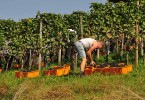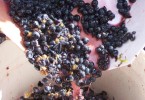Grape harvest, the ripeness of the grapes
It is called grape harvest the moment where the grapes, addressed to the production of wine are collected and placed in the wineries. This happens in the period when the bunch of grape reaches their ideal ripeness.
Grape harvest: the ripeness of the grapes
When the grapes start to become bigger and coloured, it starts the process of ripeness of the grapes. In this phase the pulp becomes soft and the sugar concentrated in the grapes, above all the fructose, called also grape sugar.
During the process of ripeness of the grapes, some substances of the grape decrease, like the malic acid responsible of the sour taste. This is the reason why the non-ripened grapes or cultivated in cold areas make the wine sour and unpleasant.
The ripeness of the grapes is one of the fundamental elements for the decision of the period called grape harvest. It, in fact, defines the relations between sugar and acids, and is called technologic ripeness.
Instead, we talk about phenolic ripeness when the cellular membrane is located in the perfect position to allow the maximum dissolution of the must and the phenolic components, to make the wine more structured.
The ideal situation for the grape harvest is when the technologic and phenolic ripeness coincides.
Grape harvest: external elements
As for the degree of ripeness of the grapes and the choice of the period of the grape harvest, consider some external factors like the environment and the cultural techniques of the vine variety. What define the period of the grape harvest is strictly tied to the environment:
Altitude and latitude: the vine is a plant that needs ideal climatic condition for the production of high-quality fruits, with a little discomfort with the excessive cold or heat. The areas where it can be developed best are enclosed between 40° and 50° parallel of our hemisphere (for instance the area of Rein in Germany) and between 30° and 40° parallel in the austral hemisphere.
Climate: the ideal climatic areas for the vines are the ones located in the hills or in the mountains, where the exposure of the leaves to the sun is maximum and the temperature is fresh and ventilated with a small quantity of humidity.
Soil: the vines prefer poor soils: cloy, sandy and calcareous, able to give to the wines perfumes and particular colours.
Among the external factors that determine the degree of ripeness there are also the techniques of the implantation: light breeding enhance the ripeness of the grapes also in cold areas, whereas intense cultivation reduce it.
Manual and mechanical grape harvest
As for the type of grape harvest, it is necessary to make two fundamental distinctions between manual and mechanical grape harvest.
Manual harvest consists in cutting with the scissors bunch of grapes and places them in boxed and baskets to be moved to the cellar.
This system is pretty delicate and allow to choose if picking or not the grapes according to their ripeness. Moreover bunch of grape can be placed in containers paying attention to not smash them.
The mechanical harvest is for sure faster and easier: it allows to reduce the costs of manpower and it can speed up the process of picking. Nevertheless this system doesn’t allow you to choose the grapes to pick and it cannot take place in the areas of mountain and plain.







